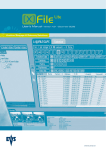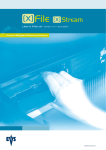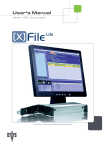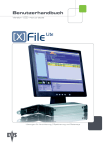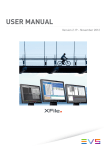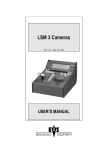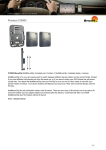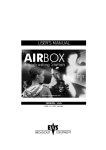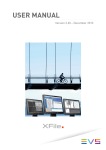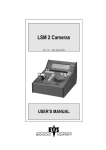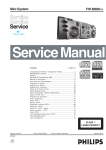Download User's manual - CreativeConsultant.be
Transcript
XFILE User’s manual Version 1.02.00 – JUNE 2004 XFILE Version 1.02.00 – User’s Manual Author: M. Lothaire Issue 3.0 Table of Contents TABLE OF CONTENTS......................................................................................... 1 INTRODUCTION ................................................................................................... 2 CONFIGURATION................................................................................................. 4 Hardware .............................................................................................................. 4 Software installation ............................................................................................ 5 SOFTWARE MANAGEMENT................................................................................ 8 Start-up ................................................................................................................. 8 System configuration..........................................................................................11 Session configuration.........................................................................................13 Autobackup mode ...............................................................................................20 Backup mode ......................................................................................................34 Restore mode ......................................................................................................36 Maintenance mode..............................................................................................40 Clip Info ..........................................................................................................40 Disk Maintenance............................................................................................46 Import / Export functions ....................................................................................47 Statistics..............................................................................................................48 NEXT VERSIONS.................................................................................................49 1 Issue 3.0 XFILE Version 1.02.00 – User’s Manual Author: M. Lothaire Introduction Digital Archiving on removable media The XFile has access to all footage recorded on LSM-XT, maXS, AirBox and Spotbox servers through the SDTI network. When a clip is created on one of the servers, a copy is automatically transferred to X-File. This copy is a background process, and as a lower priority on the network compared to real-time transfers between servers for remote playback, in order not to disturb the live production in any way. If the network is not very busy, the transfer to the removable media can be performed several times faster than real-time. As soon as real-time transfers are required on the network, the backup process is slowed down to make enough bandwidth available to guarantee these new requests. Each clip is saved as a separate file on the removable media, including not only video, audio and time code information, but also all metadata 2 XFILE Version 1.02.00 – User’s Manual Author: M. Lothaire Issue 3.0 associated with that clip: name, descriptors, creation date, original location (server s/n, register), etc. The transfer between a maXS or LSM to the X-File is a data transfer, i.e. no decoding/encoding process takes place at any point, preserving the original quality of the footage, including super-motion character if applicable. The X-File is equipped with 2 removable media, working as mirrored drives: each clip is automatically saved as 2 separate files on these drives. This provides a security copy in case of drive failure, and also gives the possibility to send these 2 drives to 2 different locations/studios after the show. Each removable media has a capacity of 250GB or 16 hours of footage at standard bitrate. More X-File stations can be inserted on the network if more archive copies are required. The X-File can also be used as a security backup of the network: should one server lose its footage for any reason (accidental delete for instance), clips can be restored from the X-File to any other server (LSM-XT, maXS or Airbox) on the network. All Super-motion clips, created on any networked LSM-XT, are stored by XFile amongst the normal files. The 75 fps nature of such material is maintained during archiving and is restored in a single pass without alteration. Therefore, restored Super-motion clips can be re-used as Super-motion footage (playback at 33%) or as a standard material (variable speed) just as if they where captured from the super-motion camera just now. The combination of maXS, LSM-XT, Airbox and X-File, all interconnected on SportNet, forms the basic architecture required to move from a mostly tape-based production to a disk-based environment. 3 XFILE Version 1.02.00 – User’s Manual Author: M. Lothaire Issue 3.0 Configuration Hardware The Xfile software is installed in a workstation operating under Windows XP. The minimum system requirement is P4 2.4Ghz Processor, P4SAA MotherBoard with DRAM 512MB and a EVS PCX board. The hardware components are housed in a 2U rack cabinet equipped with 2 x ATA 133 250GB Mobile Cartridges. The XFILE platform is included in the Sportnet in which LSM-XT, maXS Spotbox and Airbox servers interact via SDTI network. 4 XFILE Version 1.02.00 – User’s Manual Author: M. Lothaire Issue 3.0 Software installation From Disk 1, run XFILE INSTALLER and then follow the steps of the Setup Wizard: 1. Accept the software licence agreement; 2. Do not modify the S/N of the system. This S/N is hard-coded in factory. 3. Select the destination directory to install the new software; 4. Select the items to install: 5 Issue 3.0 XFILE Version 1.02.00 – User’s Manual Author: M. Lothaire Main files MMEUniversalPlayer (for VGA preview). Note: MMEPlayer is a stand-alone software and can be installed on a PClaptop for MXF files preview Drivers of PCX board. EVS Log collector. 5. Select the start menu folder to place the application’s shortcuts; 6. Then select the application mode: Xfile mode is the default application containing all the features. SportServer mode creates the link with SportServer Database. (see Sport server docum ent at i on f or det ai l s) 7. Then press INSTALL to start the installation of the Main Files and the MMEUniversalPlayer. A progress bar shows the activity of files transfer. 8. Insert DISK 2 when required. Note: A Microsoft message appears to notice a missing logo-licence, press CONTINUE ANYWAY to continue. 6 XFILE Version 1.02.00 – User’s Manual Author: M. Lothaire Issue 3.0 9. The Setup Wizard will continue with the PCX Drivers installation. Press INSTALL to load the drivers. 10. The last step of the process is the LOG_INSPECTOR installation. Press INSTALL to begin. 11. Then press QUIT for ending the installation process. The Xfile installation is successfully completed and a XFILE shortcut is saved to your desktop. 7 Issue 3.0 XFILE Version 1.02.00 – User’s Manual Author: M. Lothaire Software management Start-up At first start the upper part of the window displays: SYSTEM CONFIGURATION AREA: This field displays the current parameters of the system. Some relevant parameters are required to connect to the Sportnet. If an error message is displayed facing one of the parameters, click on the ‘System Config’ button to enter the System configuration window. 8 XFILE Version 1.02.00 – User’s Manual Author: M. Lothaire Issue 3.0 If the values are coherent, press ‘START’: the ‘System Config’ field is replaced by the ‘Session Config’ field. SESSION CONFIG AREA This field displays the current parameters and values saved to the descriptive metadata of the MXF header and added to each clip. This data can be modified for each session in the session configuration window. STATUS AREA: The aim of this area is to check the hardware validity, the remaining capacity of disks and to verify the compatibility between the software, the drivers and the data recorded. The system automatically starts the test processing. One after the other, the different stages of the boot sequence are displayed in the Status window. If an error occurs during one stage, write the message down and contact EVS staff for support. 9 XFILE Version 1.02.00 – User’s Manual Author: M. Lothaire Issue 3.0 The last test is the connection to the Sportnet. If this stage is successful, the Xfile is ready to operate. Press ‘START’ again to enter the application. 10 XFILE Version 1.02.00 – User’s Manual Author: M. Lothaire Issue 3.0 System configuration The system configuration window is only available for modifications from the start page before start-up: system parameters are required to complete the boot sequence and to connect to the Sportnet. During operations, this window will be displayed in read-only mode for information. NETWORK AREA Standalone mode: Tick off this option allows the operator to start the Xfile without being connected to the Sportnet. In this mode only the maintenance mode is active. 11 Issue 3.0 XFILE Version 1.02.00 – User’s Manual Author: M. Lothaire ! Note : The bandwidth, the video standard and the Database Size must be identical on all machines connected to the Sportnet. If one system is configured with a different bandwidth, video standard or database size, it will block the entire network. SDTI : (270Mbps / 540Mbps) Selects the bandwidth of the network. Video Standard: (PAL/NTSC) Selects the video standard. NTSC format is also applicable for HD formats Database Size: (6000/16000clips) Select the maximum number of clips saved to the LSM database. Net Name : The Net name defines the machine name on the network. This name is user-defined but cannot exceed 8 characters. Entering a Network Name is not mandatory because a network number is automatically given to the system, but it is recommended to easily identify all systems connected to Sportnet. Net Number: Range: [1 … 31] The Net number defines the machine number on the network. This number is user-defined. Optional SERVER mode for Xfile Xfile system can turn to SERVER mode and host the LSM database. This option is useful when no LSM-XT is present on the network. i.e.: sportnet composed by maXS systems. Note: This option has been temporary disabled to avoid disconnection problems during operation. STORAGE AREA Disk mode: (Single Disk / Dual Disk / Mirroring) Single Disk: only one disk is used. Dual Disk: When the first disk is full, the system automatically switches to the second disk. Mirroring: Same clips are saved to both disks at the same time. Path A / B: Selects the destination to save the MXF files. Depending on the Disk mode selection, one or two paths is/are active for modifications. 12 Issue 3.0 XFILE Version 1.02.00 – User’s Manual Author: M. Lothaire Important Note: At start-up, only the clips saved into the Path(s) are scanned. This means only those clips, data included, will be accessible and display in the Xfile list. To avoid long scanning process at start-up, we advise the clips to be distributed over different paths. SYSTEM AREA Serial Number: The serial number of the system is defined during the first installshield process and cannot be modified afterwards. The S/N is also written on the back plate of the mainframe. Session configuration The session configuration window is divided into 4 tabs: 1. AUTOBACKUP SELECTION This selection list is only active while Autobackup mode is disabled. All systems connected to the Sportnet are listed by net numbers. 13 Issue 3.0 XFILE Version 1.02.00 – User’s Manual Author: M. Lothaire 1. Tick off the squares representing the cameras to backup. Selected cameras appear in a green square, and unselected cameras in a red square. Note: For the Airbox and Spotbox servers all cameras must be selected. 2. Press OK to confirm the selection and to close the window. 3. Press the Autobackup button Different shortcuts are available to select cameras or systems with ease: Reset: clears all selections Backup all: selects all cameras of all systems. New systems being connected will be also backed up. Backup all present: selects all cameras of all systems currently connected to the network. Backup all Present PREF cam: selects all preferential cameras of all systems currently connected to the network. 14 Issue 3.0 XFILE Version 1.02.00 – User’s Manual Author: M. Lothaire Additional criteria: Archive status The basic working of the Xfile is to compare the content of its disks with the clips present on the Sportnet. According to the result, the missing clips on disk will be automatically backed up. If several disks are required to backup a complete session, the Archive status must be kept to avoid a second backup of same clips while changing the disks. Three conditions are required to validate the Archive status: 1. Before the Autobackup session, tick off the following box : 2. Then set the ‘DEFAULT XFILE’ parameter in the Setup menu of your LSM-XT server. (see Multicam documentation for complete information). label appears on the line of the LSM-XT server if The the ‘DEFAULT XFILE’ has been correctly defined. 3. and then activate the AUTOBACKUP by pressing the button. Note : The ‘DEFAULT XFILE’ setting allows the operator to initiate the backup of a clip from the LSM-XT server via the >ARCHIVE command (see Multicam documentation for details.) The ‘Archive Flag’ also initiates the backup of a clip as requested by the >ARCHIVE command even if the ‘DEFAULT XFILE’ is not set BUT the Archive status is not updated 15 XFILE Version 1.02.00 – User’s Manual Author: M. Lothaire Issue 3.0 Time Range The autobackup session can be defined for a specific duration. Tick off the square to activate the time range filter and press one of the Time range selection button to access this window: The ‘Time Range’ filter requires a date-time for the beginning and a datetime for the end to be valid. 1. In the calendar field select the month, then select the day of the month. 2. In the time field select the hour, use the arrows to change the value displayed or directly type the value when the field lights green. 3. Press enter to confirm your selection. 4. Enter the second selection window to enter the values for the end limit. The Autobackup criteria is now active and only the clips created into the time range will be back up. 16 XFILE Version 1.02.00 – User’s Manual Author: M. Lothaire Issue 3.0 2. MXF METADATA AREA This area displays the current parameters and values saved to the descriptive metadata of the MXF file. This data is modifiable by clicking on the value to modify. The value appears in the text field edition. After the modification, press ENTER to confirm the command. 17 Issue 3.0 XFILE Version 1.02.00 – User’s Manual Author: M. Lothaire 3. XFILE SESSION AREA Session Folder: Selects the folder destination to save the MXF files. Important note: The system checks the clips present into the session folder and its sub-folders. If a clip is not present and according to the criteria defined in the Autobackup selection tab, this clip is automatically backed up. The session folder field is only active before start-up in order to ensure the operations. Clicking on a folder displays the number of clips and the capacity of this folder. The total number of clips, the capacity and the remaining capacity are displayed in the lower part of the window for each path. The current Session Folder is always represented by a green icon. 18 XFILE Version 1.02.00 – User’s Manual Author: M. Lothaire Issue 3.0 4. ADVANCED PARAMETERS Autostart: This option auto-starts the XFILE software Autobackup at start-up: This option automatically starts the autobackup mode at start-up. Confirm Manual backup: Enables or disables the confirmation message while initiating a Backup command. Confirm Manual restore: Enables or disables the confirmation message while initiating a Restore command. 19 XFILE Version 1.02.00 – User’s Manual Author: M. Lothaire Issue 3.0 Autobackup mode Press to activate the Autobackup system acts automatically and backs up all clips defined in the Autobackup selection window. important to take account of the different updates Mode. In this mode, the according to the criteria Besides, this mode is made during operations. After the start-up, the system automatically starts two operations: the scanning disk process and the Scanning Network process. Those operations might last a few seconds depending on the number of clips present on disk and the number of clips present on the Sportnet. 20 Issue 3.0 XFILE Version 1.02.00 – User’s Manual Author: M. Lothaire Note: Other modes (backup, restore and maintenance) are also available during autobackup: several modes can operate simultaneously. Thanks to the selection list, the autobackup process is an automatic and self-operating system. When a clip is created on one of the selected servers, a copy is automatically transferred to X-File. The Xfile operates with the lower priority on the network, this means that the normal operations of others servers are not affected by the Xfile activity. If the cameras/systems selection needs to be modified, the autobackup mode must be disabled before entering the Session Configuration window. NETWORK STATUS The icon displayed in the center of the screen notices the current status of Sportnet: Connection to Sportnet is successfully done Xfile is connecting Connection to Sportnet failed Local hardware failure has been detected Stand-alone mode DISK USAGE AND DISK MODE The remaining capacity and the capacity of disks are displayed in the lower part of the window for each path. The icon displayed in the lower part of the screen notices the current disk mode in use: 21 Issue 3.0 XFILE Version 1.02.00 – User’s Manual Author: M. Lothaire Single Disk Dual Disk Mirroring STATUS AREA The transfer rate of the Backup and Restore processes is permanently evaluated and the progress bars show the activities in progress. Depending on the operations in progress, the operator has the choice between two status displays. Toggle to ‘Jobs done’ display Toggle to ‘ Scheduled jobs’ display The different operations are divided into different tabs. Use these filters to refine the selection: ‘View all’ displays all status since the start-up of the system. ‘View Last Hour’ and ‘ View Last Day’ are both quick shortcuts to display 22 XFILE Version 1.02.00 – User’s Manual Author: M. Lothaire Issue 3.0 the operation status related to the last hour or to the last 24 hours. The ‘Hide Successful’ button helps you to bring out clearly the various errors occurring during a complete session. The ‘Scheduled jobs’ field allows the operator to cancel one or all the jobs in queue. Select one/several items in the list and press ‘Cancel job’, or press ‘Cancel All Scheduled Jobs’ to delete all items in the list: The selected items are deleted from the list and the related operations in progress are stopped or the scheduled operations are cancelled. 23 Issue 3.0 XFILE Version 1.02.00 – User’s Manual Author: M. Lothaire REFINING THE SELECTION IN THE XFILE LIST: SORTING CLIPS To sort a column in alphabetical or numerical order, click on the column and click again to invert the sorting. label to display the arrow icon DEFINING COLUMNS Use the right-click button of the mouse to access this selection menu. All columns available are listed here. Select or unselect the item to be displayed or to be hidden. The Reset to Default option allows you to restore the standard display 24 Issue 3.0 XFILE Version 1.02.00 – User’s Manual Author: M. Lothaire FILTERS The upper part of the XFILE list displays a list of icons. These icons give access to the different filters to be applied to the XFILE list. The filters are available in the four modes: Autobackup, Manual Backup, Restore and Maintenance modes. Filter inactive and hidden Filter is visible but inactive Filter is active Click on the icon to display/hide the filter or use the right-click button of the mouse to access this selection menu. Creation date Note: The Creation date and the backup time are different values. The creation date depends on the date and time defined on your LSM-XT, maXS, Airbox or Spotbox. Please check the date-time of your system before operating. ‘Last Hour’ and ‘Last Day’ are both quick shortcuts to display the clips created during the last hour or during the last 24 hours. A range of date-time can be defined to sort the clips creating during that period. Click on the ‘Range’ button to open the following dialog box: 25 XFILE Version 1.02.00 – User’s Manual Author: M. Lothaire Issue 3.0 The ‘Creation date’ filter requires a date-time for the beginning and a date-time for the end to be valid. 1. In the calendar field select the month, then select the day of the month. 2. In the time field select the hour, use the arrows to change the value displayed or directly type the value when the field lights green. 3. Press enter to confirm your selection. 4. Enter the second selection window to validate the values for the end limit. The filter is now active and the clips created in between the time range defined are displayed in the Xfile list. Camera selection Tick off the squares representing the cameras and/or the PREFS cameras of the clips to be displayed in the XFile list. Selected cameras appear in a green square. 26 Issue 3.0 XFILE Version 1.02.00 – User’s Manual Author: M. Lothaire Rating Tick off the squares representing the four levels of Rating. Selected items appear in a green square and the XFile list is refreshed to display the new selection of clips. Folders The notion of Session Folder is important for adapting the folders organization and to understand what -in fine- is displayed in the Xfile list. The Session folder is created for the autobackup process. All clips created on the Sportnet, and according to the autobackup criteria, are saved to this session folder. In Autobackup mode, the Folders filter displays this selection: ‘All’ displays all the clips included in the current PATH defined in the system configuration at start-up. Note: In Dual disk mode and Mirroring mode, the Path A and the Path B can be selected separately. “Session Folder” displays all the clips included in the current Session Folder. Independently, a backup folder can be defined for saving the clips manually backed up. In this case only one backup folder is selected and its current content is displayed in the Xfile list. In backup mode, the Folders filter displays this selection: Clicking on the icon on the right side opens the following dialog box: 27 XFILE Version 1.02.00 – User’s Manual Author: M. Lothaire Issue 3.0 Only one folder can be selected at a time. For your information the current Session Folder always lights green in the list. If a new folder does not appear in the list, press the 'refresh' button to update the display. A Backup folder is assigned temporary for a particular operation. As all operations are successive and therefore entered in a queue, the system will keep in memory the folder defined at the time of the Backup’s request. As per the Backup Folder in an independent way, multiple Restore folders can be defined for displaying the clips to be restore on the Sportnet In Restore mode, the Folders filter displays this selection: The difference between ‘Restore Folder’s and ‘External Restore Folder’ depends on the Folders and Sub-folders included in the PATH. The selection of the ‘Restore folders’ does not require a scanning process because the clips have already been scanned at start-up. The 'External Restore Folder' can be an external disk or a folder not included in the PATH, therefore the content of this external folder (or external disk) needs to be scanned for extracting the data and making them available from the Xfile list. 28 XFILE Version 1.02.00 – User’s Manual Author: M. Lothaire Issue 3.0 In the ‘Restore Folders’ field, clicking on the icon on the right side opens the following dialog box: Several folders are selectable at a time. Select a folder from the list and press 'Add' to fill out the filter list. For your information the current Session Folder always lights green in the list. In the Filter list, select an item and press ‘Remove selected’ to cancel the selection of this folder. The sub-folders of the selected folder are selectable as well. Tick off the ‘Include SubFolders’ box to include them in the selection . Press 'OK' to confirm your selection and to quit the dialog box. The folders appear in the filter field. 29 XFILE Version 1.02.00 – User’s Manual Author: M. Lothaire Issue 3.0 In the ‘External Restore Folder’ field, clicking on the icon on the right side opens the following dialog box: Only one folder is available for selection. Click on one folder, press 'OK' to confirm your selection and to quit the dialog box. The label of selected folder appears in the filter field. The new folder is scanned and its content appears in the Xfile list. 30 XFILE Version 1.02.00 – User’s Manual Author: M. Lothaire Issue 3.0 Clipnames Clicking on the icon on the right side opens the following dialog box: 'Filter based on Prefix' allows to define a quick filter based on the first character or first-second-… character of a clipname. The system adds automatically a "*" sign while adding a prefix in order to mark the prefix out from the clipnames in the filter list. At start-up all clipnames assigned to the clips are extracted from the MXF files and are listed in the 'Filter based on existing Clipname' field. Select a clipname from the list and press 'Add' to fill out the filter list. Note: The number of clipnames/prefix in the list is restricted to 5 items. In the Filter list, select an item and press ‘Remove selected’ to cancel the selection of this clipname. Press 'OK' to confirm your selection and to quit the dialog box. The new clipnames appear in the filter field. 31 XFILE Version 1.02.00 – User’s Manual Author: M. Lothaire Issue 3.0 Keywords Clicking on the icon on the right side opens the following dialog box: 'Filter based on Prefix' allows to define a quick filter based on the first character or first-second-… character of a keyword. The system adds automatically a "*" sign while adding a prefix in order to mark the prefix out from the keywords in the filter list. At start-up all keywords assigned to the clips are extracted from the MXF files and are listed in the 'Filter based on existing Keyword' field. Select a keyword from the list and press 'Add' to fill out the filter list. Note: The number of keywords/prefix in the list is restricted to 5 items. In the Filter list, select a keyword and press ‘Remove selected’ to cancel the selection of this keyword. Press 'OK' to confirm your selection and to quit the dialog box. The new keywords appear in the filter field. 32 XFILE Version 1.02.00 – User’s Manual Author: M. Lothaire Issue 3.0 Media / clips The MXF file is the file containing all data related to a common audio/video data. The first clip created with this A/V data is called the MasterClip and has the particularity to get the same code for the ID-material and for the IDlouth. All clips ensued from this masterclip, either by copy, or by update, or by modifying the short IN short OUT point are linked to the MXF file and a different ID-louth is defined for each them. Selecting ‘ALL’ in the MEDIA / CLIPS filter displays all the Clips. Selecting ‘MasterClip’ displays only the MasterClips Selecting ‘Group’ displays both MasterClips and Clips linked by a “bracket” sign in the Xfile list. 33 Issue 3.0 XFILE Version 1.02.00 – User’s Manual Author: M. Lothaire Backup mode Press to enter the Backup mode. Press the Backup button to activate the mode. 1. First select the server, 2. then change the display of the list to find the clip to backup. Select the page, the bank and the camera of the clip. Select the display Select the server 34 Issue 3.0 XFILE Version 1.02.00 – User’s Manual Author: M. Lothaire 3. select the clip from the list 4. press to initiate the transfer. MULTI-SELECTION FOR MANUAL BACKUP 1. Press SHIFT or CTRL and select a batch of clips from the Sportnet list 2. Press to open the following window: 3. The clips selected are listed with the current status. If the ‘clip already on disk’ message is displayed facing one of the clip, the backup process for this clip is skipped. 4. Press ‘OK’ to confirm and to initiate the transfer. Note: All operations (Backup and Restore) are successive. 35 Issue 3.0 XFILE Version 1.02.00 – User’s Manual Author: M. Lothaire Restore mode Press to enter the Restore mode. The X-File can also be used as a security backup. Clips can be restored from the X-File to any other server (LSM-XT, maXS, Spotbox or Airbox) on the network. Press the Restore button to activate the mode. 1. Select the clip from the Xfile list 2. Select the server from the Sportnet list 3. then change the display of the list to find one location. Select the location to restore the clip in the page, the bank and the camera selection. 36 XFILE Version 1.02.00 – User’s Manual Author: M. Lothaire Issue 3.0 Select the display Select the server (MOVEclip) to initiate the transfer of the selected clip. The 4a. press UMID (ID-material/ID-louth) is preserved. 4b. or press (COPYclip) to intiate the transfer and to create a COPY of the selected clip. In this case a new ID-louth is defined. To ensure the validity of data during operations, only one UMID can be present on the same network. Then if the operator has to use identical clips on several machines, the COPYclip command is advised to restore several versions of the same clip. The following error message notices the operator if the selected clip is already present on the network: Then, the operator has to use the COPYclip command to initiate the transfer and create a copy of the clip. 37 Issue 3.0 XFILE Version 1.02.00 – User’s Manual Author: M. Lothaire In the Xfile list the clips already present on the Sportnet are displayed with blue characters Note: While restoring a clip : ID-material-ID-louth is preserved. If the LSM operator moves the clip to another location in the banks, a new IDlouth is assigned to this copy and its new data will be backed up and added to the original MXFfile. MULTI-SELECTION FOR RESTORE 5. Press SHIFT or CTRL and select a batch of clips from the Xfile list 6. select the server from the Sportnet list 7. change the display of the list to find one location and select the first location to restore the clips 8. Press or to open the following window: 38 XFILE Version 1.02.00 – User’s Manual Author: M. Lothaire Issue 3.0 If the selected location is free, the clip destination lights green. If the selected location is already filled, the clip destination lights red; in this case the restore of this clip will be aborted. A second operation is useful to restore the clip to another location on the Sportnet. The list box in the lower part of the window allows the user to choose multiple methods for restoring. Original Place : The clip returns to its previous location on the Sportnet. Original place on another LSM : The clip returns to its previous location (page, bank, …) on the Sportnet but is restored to another system. Contiguous : The group of clips is restored to all locations from A to F Contiguous based on camera selection : The group of clips is restored to location selected by the operator. Contiguous and group related clips: The system will recompose the group of related clips. For example: Clip 111A returns to location A, clip 111B returns to location B,… 39 Issue 3.0 XFILE Version 1.02.00 – User’s Manual Author: M. Lothaire Maintenance mode Press to enter the maintenance mode. CLIP INFO Click on the Clip icon to enter this mode. CLIP INFO AREA : This area displays the current parameters and values saved to the descriptive metadata of the MXF file. The thumbnails: The thumbnails defined for each file are extracted from the MJPEG files. The first thumbnail shows the SHORT IN frame and the last is the SHORT 40 XFILE Version 1.02.00 – User’s Manual Author: M. Lothaire Issue 3.0 OUT frame. The REF frame is automatically defined at the middle duration of the clip. The XFILE versions previous to the version 1.01.05 do not include the button to create new thumbnails thumbnails creation process. Use the or to update the current thumbnails. The thumbnail format respects the aspect ratio of the different video signals. SD clips are displayed with 4:3 aspect ratio. 16:9 SD clips are displayed with the usual black strips. HD clips are displayed with 16:9 aspect ratio. 41 XFILE Version 1.02.00 – User’s Manual Author: M. Lothaire Issue 3.0 The Data: The MXF file is the file containing all data related to a common audio/video data. Different clips are therefore linked to the same MXF file. The first parameters (dark blue) display the common parameters, the A/V parameters given by the Sportnet: clip duration, TC IN and OUT excl., IDmaterial, creation date-time, the video standard and format, number of video signals (SLSM = 3), number of audio tracks, audio type and the number of clips included in this MXF file. The following parameters (light-blue) are divided by clip section. These parameters can be different from one clip to the other: the unique ID-louth, rating, clipname, LSM clip number, Short In and out points, duration and the different keywords. The last parameters (dark blue) display the current values saved to the Session configuration window. These parameters are common for each clip. Note: The data are not modifiable. This functionality will be available in a next version 42 Issue 3.0 XFILE Version 1.02.00 – User’s Manual Author: M. Lothaire DELETE CLIP / DELETE FILE: As several clips are linked to a file the delete command has been split in 2 buttons: Delete File and Delete Clip: To mark the clips and the files out, it is advised to change the display to 'Group' in the ‘Media / Clips’ filter. The group of clips are represented with brackets in the Xfile list. MULTI-SELECTION FOR DELETE FILE: 1. Press SHIFT or CTRL and select a batch of files from the Xfile list 2. Press to open the following window: 3. This window allows the operator to review the files before deletion. Pay attention to the number of clips included in each file. Deleting the file will obviously delete all the clips included into this file. 4. Press ‘Delete All files’ to confirm the command or ‘Cancel’ to abort the 43 Issue 3.0 XFILE Version 1.02.00 – User’s Manual Author: M. Lothaire operation. MULTI-SELECTION FOR DELETE CLIP: 1. Press SHIFT or CTRL and select a batch of clips from the Xfile list to open the following window. This window allows the 2. Press operator to review the clips before deletion: 3. Press ‘Delete All Clips’ to confirm the command or ‘Cancel’ to abort the operation. 4. If one/several clips are the last clip into the MXF file, the following message notices the operator: 44 Issue 3.0 XFILE Version 1.02.00 – User’s Manual Author: M. Lothaire 5. Press ‘OK’ to close the message box and to switch to the 'Multi-Delete Files' window (shown on a red background) 6. Press 'Delete All files' to confirm the command or 'Cancel' to abort the operation. PREVIEW CLIP: Double-click on a clip in the list or press the button. The MMEUniversal player module is loaded with the selected clip. Use the command buttons to play back the clip, to search material, to review the clip frame by frame, etc. Note: The MME player plays back the clip from the IN point to the OUT point. 45 Issue 3.0 XFILE Version 1.02.00 – User’s Manual Author: M. Lothaire DISK MAINTENANCE Click on the Disk icon to enter this mode. Note: Disk maintenance mode is only available when Mirroring Disk mode is activated. The main screen changes to display the content of Path A on the left part of the screen and the content of path B on the right part of the screen. The following filter allows the operator to refine the display of both lists by isolating the differences or the common clips: Press to gain access to the filters selection. arrows initiates a clip copy from one path to the Clicking on the other, and clicking on the arrow synchronizes both contents in a single operation. 46 XFILE Version 1.02.00 – User’s Manual Author: M. Lothaire Issue 3.0 Import / Export functions The Import/Export functions are available from the file menu in the Menu bar. Selecting one command opens the following window for clip selection: Those functions allow the operator to select a number of clips and to initiate the import/export operation from/to a remote system through the Gigabit Ethernet connection. This operation can take place at the same time as a normal backup and/or restore process and it will be scheduled/ displayed in the status area. 47 XFILE Version 1.02.00 – User’s Manual Author: M. Lothaire Issue 3.0 Statistics Charts of statistics for restore and backup processes and for disk performances are available from the Statistics menu in the Menu bar. Other information will be added to the statistitics charts in a next version 48 Issue 3.0 XFILE Version 1.02.00 – User’s Manual Author: M. Lothaire Next versions Backup and restore of playlists LSM mode: “publication” of Xfile clips on the network Filters applied to Sportnet section Permanent and temporary codes Modifying ShortIN/ShortOUT, names and keywords into MXF files Save single frame to JPG file Define priority for clips transfers, Declare LSM with priority for backup, DVD archiving 49 Europe, Africa & Middle East : EVS Broadcast Equipment s.a. Rue Bois Saint-Jean 16 - LIEGE SCIENCE PARK - 4102 Ougree - BELGIUM Tel : +32-4-361 7000 - Fax : +32-4-361 7099 e-mail : [email protected] France : EVS France s.a. Quai Carnot 47 - 92210 Saint-Cloud - FRANCE Tel : +33-1-49379761 - Fax : +33-1-49379758 email : [email protected] Italy : EVS Italia s.r.l. Via Cipro 96 - 25124 Brescia - ITALY Tel: +39-030 242 71 34 Fax: +39-030 2478182 e-mail : [email protected] The Americas : EVS Broadcast Equipment Inc. 9 Law Drive, Suite 200 – FAIRFIELD - NJ 07004 - USA Tel : +1 (973) 575 7811 – Hotline: +1 (973) 575 7813 - Fax : +1 (973) 575 7812 e-mail : [email protected] Asia - Pacific : EVS Broadcast Equipment s.a. 430 DB Plaza - Discovery Bay - HONG KONG Tel : +852-2914 2501 - Fax : +852-2914 2505 e-mail : [email protected] www.evs.tv



















































